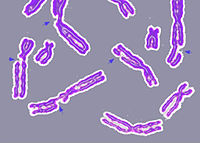
Photo from wikipedia
Objectives Niraparib maintenance after frontline chemotherapy for advanced ovarian cancer extends progression free survival. The objective of this study was to determine the cost effectiveness of niraparib maintenance therapy in… Click to show full abstract
Objectives Niraparib maintenance after frontline chemotherapy for advanced ovarian cancer extends progression free survival. The objective of this study was to determine the cost effectiveness of niraparib maintenance therapy in patients with newly diagnosed ovarian cancer. Methods Decision analysis models compared the cost of observation versus niraparib maintenance following chemotherapy for five groups: all newly diagnosed ovarian cancer patients (overall), those with homologous recombination deficiency, those harboring BRCA mutations (BRCA), homologous recombination deficiency patients without BRCA mutations (homologous recombination deficiency non-BRCA), and non-homologous recombination deficiency patients. Drug costs were estimated using average wholesale prices. Progression free survival was estimated from published data and used to estimate projected overall survival. Incremental cost effectiveness ratios per quality adjusted life year were calculated. Sensitivity analyses varying the cost of niraparib were performed. The willingness-to-pay threshold was set at US$100 000 per quality adjusted life year saved. Results For the overall group, the cost of observation was US$5.8 billion versus $20.5 billion for niraparib maintenance, with an incremental cost effectiveness ratio of $72 829. For the homologous recombination deficiency group, the observation cost was $3.0 billion versus $14.8 billion for niraparib maintenance (incremental cost effectiveness ratio $56 329). Incremental cost effectiveness ratios for the BRCA, homologous recombination deficiency non-BRCA, and non-homologous recombination deficiency groups were $58 348, $50 914, and $88 741, respectively. For the overall and homologous recombination deficiency groups, niraparib remained cost effective if projected overall survival was 2.2 and 1.5 times progression free survival, respectively. Conclusions For patients with newly diagnosed ovarian cancer, maintenance therapy with niraparib was cost effective. Cost effectiveness was improved when analyzing those patients with homologous recombination deficiency and BRCA mutations. Efforts should continue to optimize poly-ADP-ribose polymerase utilization strategies.
Journal Title: International Journal of Gynecological Cancer
Year Published: 2020
Link to full text (if available)
Share on Social Media: Sign Up to like & get
recommendations!